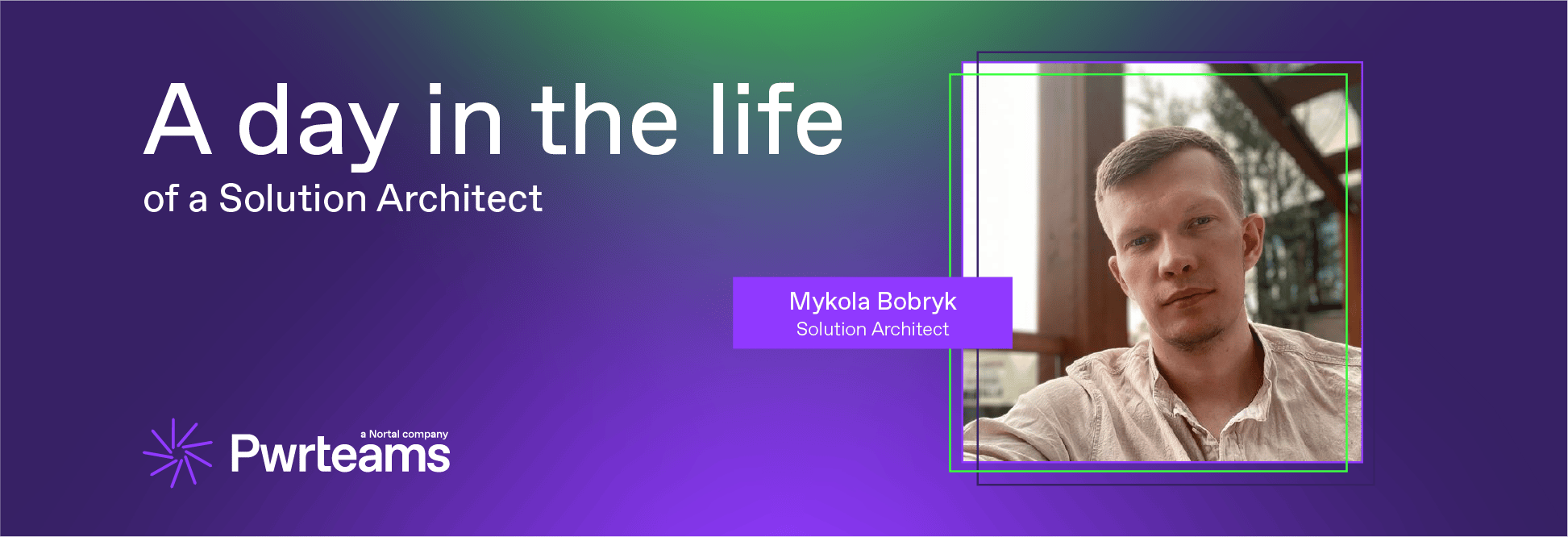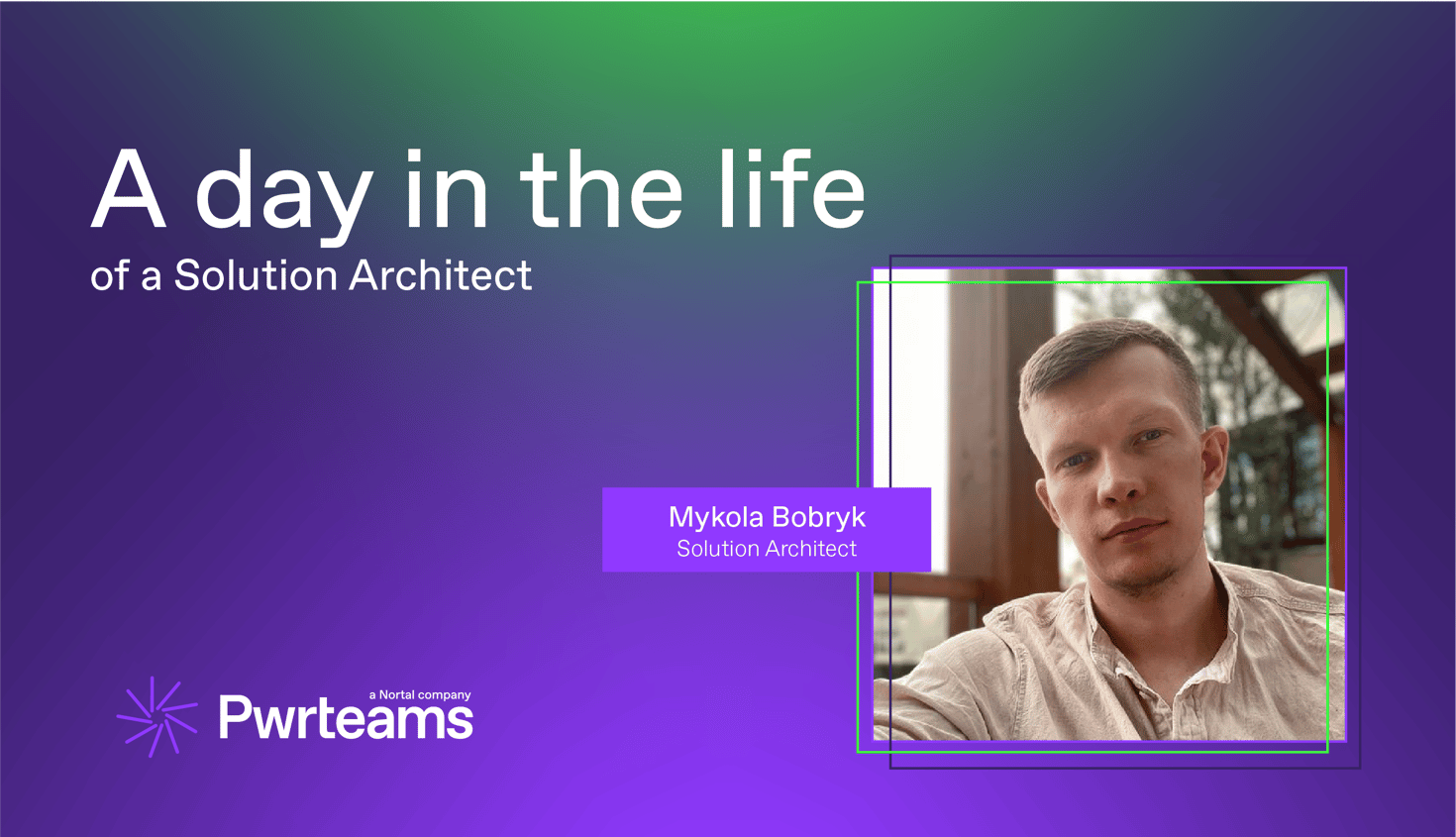A day in the life of a Solution Architect


Welcome to our "A Day in the Life" blog series – your behind-the-scenes pass into the everyday experiences, challenges and wins of different roles at Pwrteams. Each edition highlights a unique position, offering a first-hand glimpse into a typical workday. Whether you're considering joining Pwrteams, already part of the crew and curious about what your colleagues do or simply interested in the fast-paced world of our industry, this series is for you.
Recently, we caught up with Mykola Bobryk, a Solution Architect at TUI’s dedicated team at Pwrteams, who’s been with the company for seven months already. He shared his first impressions of working at Pwrteams and gave us an inside look into what a typical day in his role is like.
How did you come into this position? What was your previous background?
My journey into this role began back in 2010, during my university years. That’s when I first started working with PHP and took on freelance projects, building small scripts and getting hands-on experience. After some time, I landed my first full-time job and continued working with PHP for around 3-4 years, moving between a few companies.
Then came the rise of Node.js – it was becoming mainstream, and I couldn’t resist the hype. I gave it a try, stuck with it and eventually became Head of the Node.js stream at one of the companies. Over the years, I worked across a variety of domains – crypto, fintech, travel – both at startups and larger enterprise-level organisations.
At the end of 2021, I decided to dive deeper into software architecture and enrolled in the Software Architecture in Practice course from Carnegie Mellon University. That turned out to be a real turning point. After completing the course, I wanted to test myself in a Solution Architect role. A fintech company gave me that opportunity, and I spent the next two and a half years growing in that position.
As for Pwrteams – it happened quite unexpectedly. I wasn’t actively looking for a new job, but one day I received a message from an HR on LinkedIn. And here I am!
How does your typical day at TUI's team look like?
How does a typical day in the life of a Solution Architect look like? Well, usually something like this: meeting, meeting, lunch, meeting, a bit of architecture… and then – surprise – another meeting. I’m joking... sort of.
In all seriousness, if you're aiming to become a Solution Architect and picture yourself sketching elegant systems on a whiteboard all day, I hate to break it to you – you’ll spend a lot more time talking than drawing. Communication is a huge part of the role.
Most of my day is spent in syncs with stakeholders, discussions with development teams and alignment with other architects. And yes, somewhere between all that, I do get to focus on architecture – making design decisions, reviewing solutions and helping guide the technical direction. It’s a healthy mix of collaboration, planning and design work and surprisingly, I really enjoy the balance.
What’s your favourite part of the job?
My favourite part of the job is seeing a solution I’ve designed come to life – watching it evolve from abstract diagrams and documentation into something real that people actually use. There’s something incredibly satisfying about seeing it work exactly as intended… or, let’s be honest, close enough after a few iterations!
But what really keeps me going is the feedback, especially the positive kind – from both users and the business. Knowing that something I helped shape is solving real problems or making someone’s life easier? That’s the good stuff. It’s a great reminder that all those meetings, trade-offs and design decisions were worth it.
And the most challenging?
The most challenging part of the job is juggling all the moving pieces – aligning stakeholder expectations, understanding the current state of the system and designing a solution that’s technically sound, cost-effective and scalable.
When you’re working on something as large and complex as TUI, even adding a seemingly small feature can become a massive task. You have to consider the impact across platforms – web, mobile, backend, how it affects different teams and departments and gather input from a lot of stakeholders who often have very different priorities.
As a Solution Architect, you’re essentially the translator between the business world and the technical world. Your job is to take all those high-level requirements and turn them into something engineers can actually build without wanting to run away. And that balancing act? It’s rewarding, but definitely not easy.
What new skills have you picked up on this position?
I’d say the first skill I really levelled up in this role is stress resistance. In a world where priorities shift overnight, blockers pop up out of nowhere, and timelines love to surprise you, staying calm under pressure is essential. I’ve learned to take a deep breath, roll with the punches and keep things moving.
The second big one is flexibility and with that - the ability to find the right trade-offs. Stakeholders often come with big dreams and tight deadlines, and it’s my job to find a solution that respects business goals, technical realities and everything in between.
And finally, continuous learning. Technology doesn’t wait for anyone, and if you stop learning, you're out of the game before you know it. I’m constantly exploring new tools, architectural patterns and approaches to stay sharp and bring fresh ideas to the table.
How do you explain what you do at your job to non-IT people?
When I talk to non-IT folks about what I do, I usually use the house-building analogy. Imagine you want to build a house – you have a vision of what it should look like, how many rooms it needs, where the windows go, maybe even a fancy rooftop terrace.
Well, I’m like the architect in that scenario. I take all those ideas and figure out how to make them real. I work with the people who’ll live in the house (the stakeholders), talk to the construction crew (the dev team), check the budget, make sure the plumbing won’t flood the kitchen and that the roof won’t fall off when it rains.
So, I don’t lay the bricks myself, but I design how everything should fit together and make sure everyone’s on the same page. My job is to ensure the house doesn’t just look good, but is also safe, functional and built to last.
What makes it so great being part of TUI’s team?
What makes being part of TUI so great is the people, first and foremost. I get to work with incredibly talented professionals who are experts in their fields, which is both inspiring and motivating.
Then there’s the scale. Solving complex challenges in a product of this size is a whole different game – it pushes you to think bigger, plan smarter and grow constantly.
I also really enjoy collaborating with other architects. It’s not just about aligning on solutions – it’s a chance to learn from each other, validate ideas and sharpen your thinking. And the best part? You’re not just learning for the sake of learning – you get to apply that knowledge and actually see the impact.
What do you like the most about being part of the Pwrteams family?
What I like most about being part of the Pwrteams family is the confidence in tomorrow – there’s a strong sense of stability here, which really helps you focus on doing your best work.
On top of that, the working conditions are genuinely comfortable. The company takes care of its people – whether it’s about flexibility, work–life balance or the tools and environment we need to succeed.
But beyond the practical stuff, it’s also the culture. There’s mutual respect, a sense of belonging and a collaborative spirit. You’re surrounded by smart, driven people, but there’s no ego. It feels like a place where you’re encouraged to grow, share your ideas and actually enjoy the journey.
Keen to work alongside talented professionals like Mykola? Check out our vacancies and send us your CV – we’d love to hear from you!
Write your own
success story
with Pwrteams!
Share your details in the form, tell us about your needs, and we'll get back with the next steps.
- Build a stable team with a 95.7% retention rate.
- Boost project agility and scalability with quality intact.
- Forget lock-ins, exit fees, or volume commitments.


